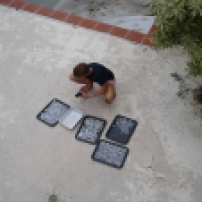It’s not all fun and games here in paradise. I mean, mostly it is- but there are some exceptions. Here’s one.
There’s a very cool thing that happens here when we go through a drought. Just behind an amazingly beautiful beach called Salt Pond, there lies an actual dark and murky saline pond. No idea about the science of this, but probably you can look it up. Anyway, it’s on the South Side of the island and if you’ve ever been here to visit us (and if not, why not?) we’ve probably taken you there for a beach day or to hike up Ram’s Head, which is a breathtaking trail. So usually that’s what we get up to when we head that way- fun and sun and happiness. But, when there’s a drought and enough water evaporates out of the pond behind the beach, the salt crystalizes and all of the locals get giddy and start talking about going over there to “get salt”. All natural, free, delicious sea salt. Who could resist? We, like many of our neighbors, grabbed a bucket and headed over.

Salt Pond Beach- where we’d take you if you came to visit.
Here’s the thing: harvesting salt is way harder that you’d think. The pond is like a muddy pool with a hard white crust of salt forming at the edges. Also, because the water table is so low there’s a not-so-delicious sulfur smell going on. You have to carefully pick a spot where you can chip away the crystals (by hand, mostly) and not break through the salt and into the mud.

Salt Pond Mine- just a short trail away from the beach.
By the way, this is all stuff we figured out after some disasters last year because no one ever tells you how to get salt. They just tell you it’s there. One of the things we learned is not to overfill your bucket. Hiking out with heavy buckets of salt flat-out sucks. All along the path back to the parking lot you can see where people have either started dumping their salt on purpose as a load lightening technique or else they dropped their bucket out of fatigue (hello, last year).

Salt Down. Bummer.

Salt Harvesting- not all it’s cracked up to be.

Huge Crystals
Even if you make it home with your bucket of salt, the work is not over. This salt is not shaker ready. This year we did a combination of processes. We dried it in the sun (excellent way to encourage rain, by the way). We picked out the debris and rinsed it. We put it in a very low oven (last year, we burned it. Did you know you could burn salt? You can.) Then we crushed it with a mortar and pestle.
Then we put it back in the oven until it was bright white and very salt like. Now it’s in jars, ready for use. It actually worked out. We’ve got a stellar end product (not like last time). We probably have 4 or 5 quarts of St. John’s finest sea salt…but it wasn’t easy.


If any of you reading this have any suggestions on how we could make this easier on ourselves next time (other than just going to the store), we’d love to hear about it in the comments.


















